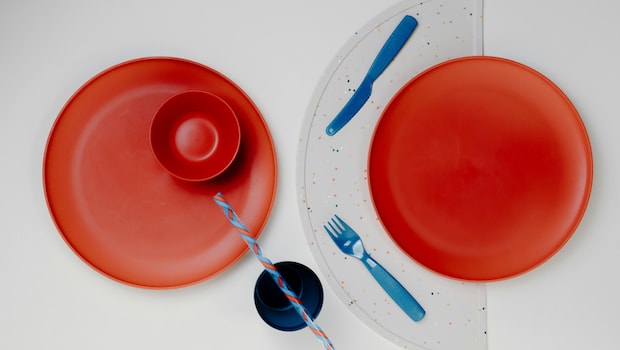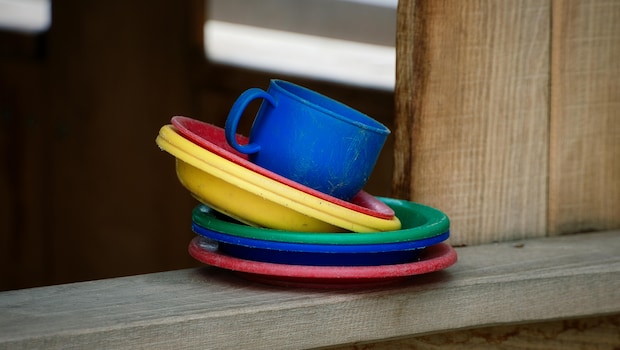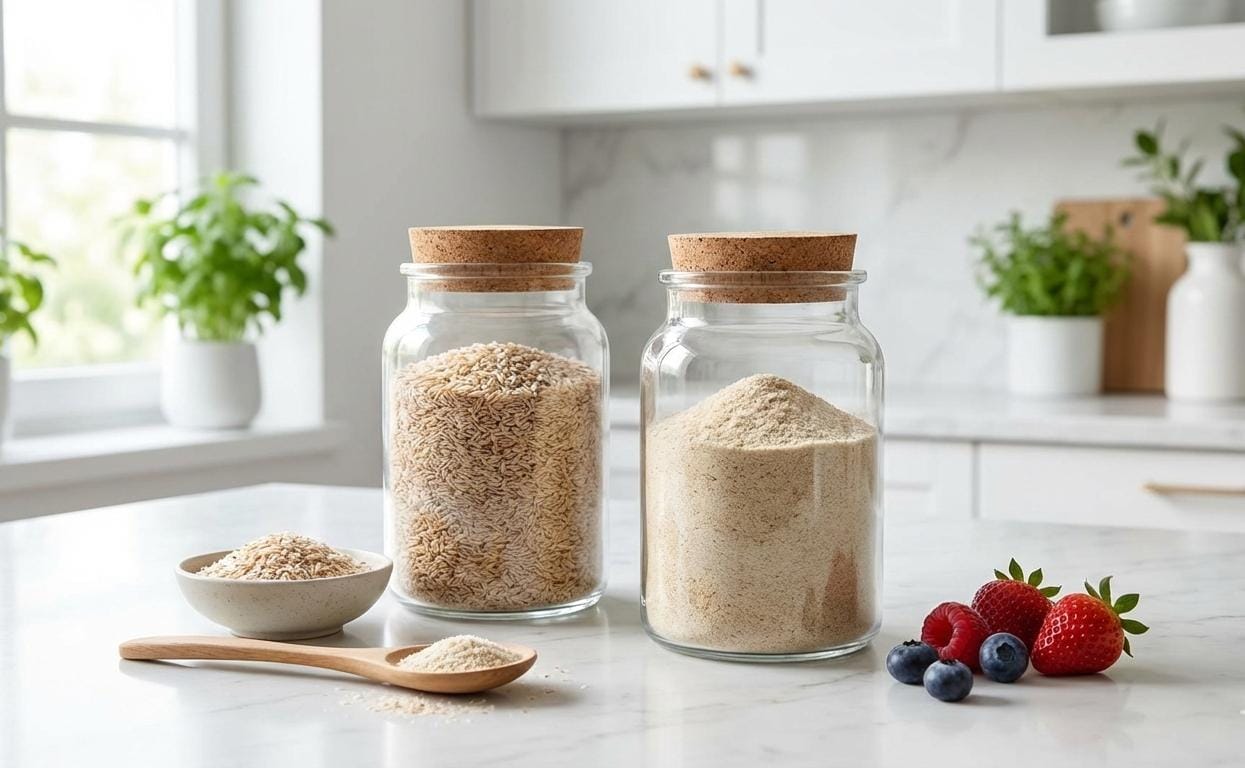Not too many years ago, we all used plastic crockery at home and loved it, especially the ones with attractive designs on them. Even today, plastic plates, bowls, and cups continue to be kitchen staples in homes across the country. Why? Because they are lightweight, affordable, and child-friendly. But that same unbreakable convenience may be masking serious health concerns. More experts are now warning about the hidden dangers of using plastic tableware at home. So, how safe is your plastic crockery, really? And how can you tell if it is affecting your health or your family's?
Also Read: 5 Signs You Should Throw Away Your Plastic Food Storage Containers
What Is BPA, And Why Should You Check Your Plastic Crockery For It?
Many plastic plates, cups, containers and even lunch boxes are made using chemicals such as BPA. If you turn over your plastic dinnerware, particularly older or cheaper items, you might notice markings like "BPA" or "BPA-free" on the bottom. BPA stands for Bisphenol A, a synthetic chemical used to help plastics retain shape and flexibility. But it is also one of the most notorious endocrine disruptors, chemicals known to interfere with the body's hormone systems.
Why Is BPA Harmful
According to clinical nutritionist Rupali Datta, both BPA and another common compound, phthalates, are endocrine disruptors that can affect hormones such as oestrogen and testosterone. This makes them especially concerning for children, since these hormones are crucial for physical development, reproductive health and overall growth.
The Paediatric Environmental Health Speciality Unit (PEHSU) in the United States has also warned that these chemicals may alter the natural course of development in children and contribute to long-term health issues.
Also Read: Why You Should Never Throw Away Food Delivery Boxes Without Doing This First

Most of the old plastic crockery contains BPA
Why Plastic Tableware With BPA May Pose A Serious Health Risk
Renowned expert Dr Tracey Woodruff, Professor at UC San Francisco, highlights that chemicals like BPA, phthalates, and PFAS (another synthetic compound commonly used in plastics) can imitate human hormones. This interference has been linked to a range of health issues, from reproductive problems and infertility to poor foetal development and even certain types of cancer.
A two-part study conducted by Chinese researchers added another dimension to these concerns. It found that plastic exposure could increase the risk of cardiovascular disease (CVD). The study explained how plastic chemicals that leach into food can alter gut microbiota, elevate inflammation, and cause oxidative stress, triggers that contribute to heart and metabolic disorders.
In more severe cases, plastic build-up in the body has been linked to kidney stones, kidney failure, and in extreme instances, death.
Can Microplastics From Crockery Accumulate In The Body?
As awareness around microplastics grows, researchers are uncovering just how deeply they are entering the human body. Studies have found microplastics in human blood, lungs, liver tissue, and even the placenta. Daily use of plastic crockery, especially with hot, acidic, or oily foods, can accelerate this exposure.
When plastic breaks down or is exposed to heat, tiny plastic particles can migrate into food and beverages. Over time, this adds up. According to a study published in Environmental Science & Technology, the average person may ingest tens of thousands of microplastic particles each year. While the full health impact of this is still being studied, scientists are increasingly concerned about their link to inflammation, metabolic disruption, and even autoimmune diseases.
Also Read: How To Clean Plastic Food Containers Using Common Kitchen Ingredients

Plastic crockery may harm our health and the environment
Should You Use Plastic Crockery?
What The FDA Says:
While research continues to point to potential risks, the U.S. Food and Drug Administration (FDA) maintains that if used correctly, the chances of plastic chemicals leaching into food remain low. This includes not heating plastic crockery unless it is clearly labelled microwave-safe, and avoiding the use of plastic with acidic foods.
However, recent studies challenge this reassurance. Research published in The Innovation Medicine found that plastic dinnerware releases significantly more microplastics when exposed to heat. Everyday meals like tea, coffee, or soup - often served hot - may accelerate the breakdown of plastic, introducing tiny particles into food. Over time, this could contribute to chronic health conditions, though further research is ongoing.
Is Melamine Crockery Safer Than Plastic?
Melamine crockery is widely seen as a fancier alternative to plastic in many Indian homes. But what many people do not realise is that melamine itself is a type of plastic resin, made by combining melamine and formaldehyde. While it is sturdier and often better looking, it still carries health risks, particularly when used with hot foods.
Research shows that melamine can leach into food, especially when exposed to high heat or acidic ingredients. According to the World Health Organization (WHO), repeated exposure to melamine has been associated with kidney-related health concerns. It is also not microwave-safe unless explicitly labelled.
For households looking to upgrade from plastic, it is important to remember that melamine is not necessarily a safer option unless used carefully.
What Indian Regulations Say About Plastic Crockery
While the article has referenced global institutions, India too has growing regulatory frameworks around plastic use. The Food Safety and Standards Authority of India (FSSAI) has issued guidelines for food-grade plastic, stating that all plastic used for food contact must meet specific standards related to migration limits and chemical composition.
Additionally, the Bureau of Indian Standards (BIS) has specifications for plastics used in food containers. Despite these standards, enforcement remains inconsistent, and many inexpensive plastic items sold in local markets may not comply. On an environmental level, several Indian states have also enforced partial or full bans on single-use plastics.
Given these evolving regulations, consumers are encouraged to check for BIS markings, microwave-safety labels, and FSSAI compliance before purchasing plastic crockery.
What To Look For When Choosing Safer Plastic Crockery
If you are not yet ready to stop using plastic entirely, it is worth knowing what to look for when buying or checking your current tableware. Some quick checks:
- Avoid plastic marked with phthalates, styrene, or bisphenols
- Look for items labelled BPA-free, bio-based, or Greenware
- Ensure plastic containers are marked microwave-friendly
- Choose brands that disclose material safety information
- The Environmental Working Group (US) recommends sticking to BPA-free plastics even for food storage, though the safest course is to minimise plastic use altogether.
Should You Still Be Using Plastic Crockery?
The convenience and affordability of plastic crockery is clear. However, the mounting health evidence suggests that long-term exposure, particularly when the plastic is heated, may be doing more harm than good. Experts agree that plastic should not be the default option for daily meals, especially when safer alternatives exist. It is also important to consider the environmental impact. Plastic is not biodegradable. It lingers in landfills for centuries, pollutes oceans, and contributes significantly to the global plastic crisis. Its production and disposal have environmental consequences that go far beyond your kitchen.
Best Alternatives To Plastic Tableware For Health And Sustainability

Melamine dinnerware is a better option than plastic
The good news? You do not need to sacrifice style or practicality to avoid plastic. Safer, sustainable options are now easily available and are often more durable over time.
Consider switching to:
- Stainless Steel: Long-lasting, heat-resistant, and child-friendly
- Ceramic: Safe for hot and cold meals, easy to clean, and microwave-safe
- Glass: Non-toxic, transparent, and does not absorb flavours or stains
- Bamboo: Lightweight, biodegradable, and environmentally responsible
These alternatives can transform your dining experience while also reducing health risks and environmental impact.
Plastic crockery may have been a practical kitchen staple for years, but it comes with growing concerns, both for your health and for the planet. The evidence is building, and the advice from experts is becoming increasingly clear. It may be time to reassess what is on your table. Your meals deserve better than plastic.










